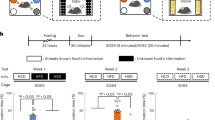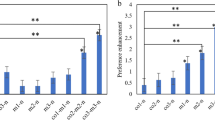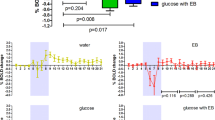Abstract
Objective:
Olfacto-gustatory sensory-specific satiety plays an important role in the termination of food ingestion. A defect in this mechanism, by increasing food intake, could be a factor in development of overweight. The present study was conducted to explore whether sensory-specific satiety in the overweight may be different from that in normal-weight subjects.
Subjects:
144 subjects (half men, half women; age range: 17–62 years; BMI range: 17–39 kg m−2).
Measurements:
Olfactory pleasure (OP) and flavor pleasure (FP) were evaluated before and after ingestion of a single chosen food. Six foods from three classes were offered: cucumber and tomato, pineapple and banana, and peanut and pistachio. According to the subjects' preference for one of them, subjects were classified into six groups (24 subjects each with equal sex ratio). The experimental sequence was (1) evaluation of the six foods (OP), (2) ad libitum intake of the preferred food (FP) and (3) second evaluation of the six foods (OP).
Results:
Food intake was limited by sensory-specific satiety (that is, a decline in FP for the ingested food) in overweight subjects just as it was in the leanest. There was no significant correlation between BMI and hedonic parameters (OP and FP) or intakes (quantity and volume). Pre-ingestive OP and FP correlated with the ingested food's weight (OP: r=0.468; FP: r=0.415; P<0.01), volume (OP: r=0.428; FP: r=0.407; P<0.01) and intake duration (OP: r=0.184; FP: r=0.343; P<0.05). The decline in OP, but not in FP, correlated with ingested weight (r=0.271, P<0.01) and volume (r=0.263, P<0.01) but not with duration.
Conclusion:
After intake of a single food, olfacto-gustatory sensory-specific satiety correlated with the ingested food's weight and volume and with the duration of ingestion, but not with bodyweight. This suggests that overweight and lean subjects have similar hedonic control of food intake with simple foods.
This is a preview of subscription content, access via your institution
Access options
Subscribe to this journal
Receive 12 print issues and online access
$259.00 per year
only $21.58 per issue
Buy this article
- Purchase on Springer Link
- Instant access to full article PDF
Prices may be subject to local taxes which are calculated during checkout

Similar content being viewed by others
References
Sclafani A, Berner CN . Influence of diet palatability on the meal taking behavior of hypothalamic hyperphagic and normal rats. Physiol Behav 1976; 16: 355–363.
Rolls BJ, Rowe EA, Rolls ET . How sensory properties of foods affect human feeding behaviour. Physiol Behav 1982; 29: 409–417.
Rolls BJ, Rowe EA, Rolls ET, Kingston B, Megson A, Gunary R . Variety in a meal enhances food intake in man. Physiol Behav 1981; 26: 215–221.
Raynor HA, Epstein LH . Dietary variety, energy regulation, and obesity. Psychol Bull 2001; 127: 325–341.
Rolls BJ, Hetherington MM . The role of variety in eating and body weight regulation. In: Shepherd R (ed). Handbook Psychophysiol Human Eating. Wiley: Chichester, 1989. pp 57–84.
Louis-Sylvestre J, Giachetti I, Le Magnen J . Sensory versus dietary factors in cafeteria-induced overweight. Physiol Behav 1984; 32: 901–905.
Sorensen LB, Moller P, Flint A, Martens M, Raben A . Effect of sensory perception of foods on appetite and food intake: a review of studies on humans. Int J Obes Relat Metab Disord 2003; 27: 1152–1166.
de Graaf C, Blom WA, Smeets PA, Stafleu A, Hendriks HF . Biomarkers of satiation and satiety. Am J Clin Nutr 2004; 79: 946–961.
Le Magnen J . Sur le mécanisme d'établissement des appétits caloriques (Mechanism of establishment of caloric appetites). C R Hebd Séances Acad Sci 1955; 240: 2436–2438.
Booth DA . Conditioned satiety in the rat. J Comp Physiol Psychol 1972; 81: 457–471.
Cabanac M . Physiological role of pleasure. Science 1971; 173: 1103–1107.
Cabanac M, Fantino M . Origin of olfacto-gustatory alliesthesia: intestinal sensitivity to carbohydrate concentration? Physiol Behav 1977; 18: 1039–1045.
Rolls BJ, Rolls ET, Rowe EA, Sweeney K . Sensory specific satiety in man. Physiol Behav 1981; 27: 137–142.
Rolls ET, Rolls JH . Olfactory sensory-specific satiety in humans. Physiol Behav 1997; 61: 461–473.
Hetherington M, Rolls BJ, Burley VJ . The time course of sensory-specific satiety. Appetite 1989; 12: 57–68.
Fantino M . Role of sensory input in the control of food intake. J Auton Nerv Syst 1984; 10: 347–358.
Nasser J . Taste, food intake and obesity. Obes Rev 2001; 2: 213–218.
Drewnowski A, Kurth C, Holden-Wiltse J, Saari J . Food preferences in human obesity: carbohydrates versus fats. Appetite 1992; 18: 207–221.
Mela DJ, Sacchetti DA . Sensory preferences for fats: relationship with diet and body composition. Am J Clin Nutr 1991; 53: 908–915.
Cox DN, Perry L, Moore PB, Vallis L, Mela DJ . Sensory and hedonic associations with macronutrient and energy intakes of lean and obese consumers. Int J Obes Relat Metab Disord 1999; 23: 403–410.
Blundell JE, Hill AJ . On the mechanism of action of dexfenfluramine: effect on alliesthesia and appetite motivation in lean and obese subjects. Clin Neuropharmacol 1988; 11 : S121–S134.
Frankham P, Gosselin C, Cabanac M . Diet induced weight loss accelerates onset of negative alliesthesia in obese women. BMC Public Health 2005; 18: 112–120.
Evans SM, Foltin RW . Menstrual cycle changes in food ‘cravings’ and sensory-specific satiety in lean and obese women (Abstract). Obes Res 1999; 7: 68S.
Snoek HM, Huntjens L, Van Gemert LJ, De Graaf C, Weenen H . Sensory-specific satiety in obese and normal-weight women. Am J Clin Nutr 2004; 80: 823–831.
Romer M, Lehrner J, Van Wymelbeke V, Jiang T, Deecke L, Brondel L . Does modification of olfacto-gustatory stimulation diminish sensory-specific satiety in humans? Physiol Behav 2006; 1: 469–477.
Cabanac M . Regulation and the ponderostat. Int J Obes Relat Metab Disord 2001; 25: S7–S12.
Woods SC, Seeley RJ . Adiposity signals and the control of energy homeostasis. Nutrition 2000; 16: 894–902.
Speakman JR, Stubbs RJ, Mercer JG . Does body mass play a role in the regulation of food intake? Proc Nutr Soc 2002; 61: 473–487.
de Castro JM, Plunkett S . A general model of intake regulation. Neurosci Biobehav Rev 2002; 26: 581–595.
Tremblay A . Dietary fat and body weight set point. Nutr Rev 2004; 7/2: S75–S77.
Levin BE . Factors promoting and ameliorating the development of obesity. Physiol Behav 2005; 86: 633–639.
Lowe MR, Friedman MI, Mattes R, Kopyt D, Gayda C . Comparison of verbal and pictorial measures of hunger during fasting in normal weight and obese subjects. Obes Res 2000; 8: 566–574.
Torgerson JS, Lissner L, Lindroos AK, Kuijer H, Sjöström L . VLCD plus dietary and behavioural support alone in the treatment of severe obesity. A randomised two-year clinical trial. Int J Obes Relat Metab Disord 1997; 21: 987–994.
McCrory MA, Suen VM, Roberts SB . Biobehavioral influences on energy intake and adult weight gain. J Nutr 2002; 132: 3830S–3834S.
Guy-Grand B, Sitt Y . Alliesthésie gustative dans l'obésité humaine. Nouv Presse Med 1974; 3: 92–93.
Keim NL, Stern JS, Havel PJ . Relation between circulating concentrations and appetite during a prolonged, moderate energy deficit in women. Am J Clin Nutr 1998; 68: 794–801.
Heini AF, Lara-Castro C, Kirk KA, Considine RV, Caro JF, Weinsier RL . Association of leptin and hunger-satiety ratings in obese women. Int J Obes Relat Metab Disord 1998; 22: 1084–1087.
Cummings DE, Weigle DS, Frayo RS, Breen PA, Ma MK, Patchen Dellinger E et al. Plasma ghrelin levels after diet-induced weight loss or gastric bypass surgery. N Engl J Med 2002; 346: 1623–1630.
Berridge KC . Modulation of taste affect by hunger, caloric satiety, and sensory-specific satiety in the rat. Appetite 1991; 16: 103–120.
Cornier MA, Grunwald GK, Johnson SL, Bessesen DH . Effects of short-term overfeeding on hunger, satiety, and energy intake in thin and reduced-obese individuals. Appetite 2004; 43: 253–259.
de Graaf C . Sensory responses, food intake and obesity. In: Mela DJ (ed). Food Diet and Obesity. Woodhead Publishing Ltd: Cambridge, 2005, pp 137–159.
Mattes RD . 6-n-Propylthiouracil taster status: dietary modifier, marker or misleader? In: Prescott J, Tepper BJ (eds). Genetic Variation in Taste Sensitivity. Marcel Dekker Inc: New York, 2004. pp 229–250.
Thompson DA, Moskowitz HR, Campbell RG . Taste and olfaction in human obesity. Physiol Behav 1977; 19: 335–337.
Frijters JE . Sweetness intensity perception and sweetness pleasantness in women varying in reported restraint of eating. Appetite 1984; 5: 103–108.
Rissanen A, Hakala P, Lissner L, Mattlar CE, Koskenvuo M, Ronnemaa T . Acquired preference especially for dietary fat and obesity: a study of weight-discordant monozygotic twin pairs. Int J Obes Relat Metab Disord 2002; 26: 973–977.
Mela DJ, Sacchetti DA . Sensory preferences for fats: relationships with diet and body composition. Am J Clin Nutr 1991; 53: 908–915.
Fisher JO, Birch LL . Fat preferences and fat consumption of 3- to 5-year-old children are related to parental adiposity. J Am Diet Assoc 1995; 95: 759–764.
Hill SW, McCutcheon NB . Eating responses of obese and nonobese humans during dinner meals. Psychosom Med 1975; 37: 395–401.
Spiegel TA, Shrager EE, Stellar E . Responses of lean and obese subjects to preloads, deprivation, and palatability. Appetite 1989; 13: 45–69.
Yeomans MR, Blundell JE, Leshem M . Palatability: response to nutritional need or need-free stimulation of appetite? Br J Nutr 2004; 92: S3–S14.
Blundell JE, Gilett A . Control of food intake in the obese. Obes Res 2001; 9: 263S–270S.
Laeng B, Berridge KC, Butter C . Pleasantness of a sweet taste during hunger and satiety: effects of gender and ‘sweet tooth’. Appetite 1993; 21: 247–254.
Wansink B, Cheney MM, Chan N . Exploring comfort food preferences across age and gender. Physiol Behav 2003; 79: 739–747.
Westenhoefer J . Age and gender dependant profile of food choice. Forum Nutr 2005; 57: 44–51.
Rolls BJ, McDermott T . Effects of age on sensory-specific satiety. Am J Clin Nutr 1991; 54: 988–996.
Mojet J, Christ-Hazelhof E, Heidema J . Taste perception with age: generic or specific losses in threshold sensitivity to the five basic tastes? Chem Senses 2001; 26: 845–860.
Duffy VB, Backstrand JR, Ferris AM . Olfactory dysfunction and related nutritional risk in free-living, elderly women. J Am Diet Assoc 1995; 95: 879–884.
Roberts SB, Rosenberg I . Nutrition and aging: changes in the regulation of energy metabolism with aging. Physiol Behav 2006; 86: 651–667.
Bobroff EM, Kissileff HR . Effects of changes in palatability on food intake and the cumulative food intake curve in man. Appetite 1986; 7: 85–96.
Yeomans MR . Palatability and the micro-structure of feeding in humans: the appetizer effect. Appetite 1996; 27: 119–133.
Bell EA, Roe LS, Rolls BJ . Sensory-specific satiety is affected more by volume than by energy content of a liquid food. Physiol Behav 2003; 78: 593–600.
Rolls BJ, Hetherington M, Laster LJ . Comparison of the effects of aspartame and sucrose on appetite and food intake. Appetite 1988; 11 : 62–67.
Birch LL, Deysher M . Caloric compensation and sensory specific satiety: evidence for self-regulation of food intake by young children. Appetite 1986; 7: 323–331.
Gelieber A, Westreich S, Gage D . Gastric distension and gastric capacity in relation to food intake in humans. Physiol Behav 1988; 44: 665–668.
Phillips RJ, Powley TL . Gastric volume rather than nutrient content inhibits food intake. Am J Physiol 1996; 271: R766–R769.
Hoad CL, Rayment P, Spiller RC, Marciani L, de Celis Alonso B, Traynor C et al. In vivo imaging of intragastric gelation and its effect on satiety in humans. J Nutr 2004; 134: 2293–2300.
Rolls BJ, Hetherington M, Burley VJ . Sensory stimulation and energy density in the development of satiety. Physiol Behav 1988; 44: 727–733.
Rolls BJ, Laster LJ, Summerfelt A . Hunger and food intake following consumption of low-calorie foods. Appetite 1989; 13: 115–127.
Miller DL, Bell EA, Pelkman CL, Peters JC, Rolls BJ . Effects of dietary fat, nutrition label, and repeated consumption on sensory-specific satiety. Physiol Behav 2000; 71: 153–158.
Norton GN, Anderson AS, Hetherington MM . Volume and variety: relative effects on food intake. Physiol Behav 2006; 87: 714–722.
de Castro JM . Macronutrient and dietary energy densities influences on the intake of free-living humans. Appetite 2006; 46: 1–5.
Stubbs RJ, Ferres S, Horgan G . ED of foods: effects on energy intake. Crit Rev Food Sci 2000; 40: 481–515.
Devitt AA, Mattes RD . Effects of food unit and energy density on intake in humans. Appetite 2004; 42: 213–220.
Rolls BJ, Roe lS, Meengs JS . Reductions in portion size and energy density of foods are additive and lead to sustained decreases in energy intake. Am J Clin Nutr 2006; 83: 11–17.
Rolls BJ . The role of energy density in the overconsumption of fat. J Nutr 2000; 130: 268S–271S.
Kral TV, Rolls BJ . Energy density and portion size: their independent and combined effects on energy intake. Physiol Behav 2004; 82: 131–138.
Acknowledgements
Special thanks to André Holley for editorial advice. We also thank the English department of the Faculty of Medicine of Dijon for revision of the manuscript.
Author information
Authors and Affiliations
Corresponding author
Rights and permissions
About this article
Cite this article
Brondel, L., Romer, M., Van Wymelbeke, V. et al. Sensory-specific satiety with simple foods in humans: no influence of BMI?. Int J Obes 31, 987–995 (2007). https://doi.org/10.1038/sj.ijo.0803504
Received:
Revised:
Accepted:
Published:
Issue Date:
DOI: https://doi.org/10.1038/sj.ijo.0803504
Keywords
This article is cited by
-
Short-term effects of a green coffee extract-, Garcinia c ambogia- and l-carnitine-containing chewing gum on snack intake and appetite regulation
European Journal of Nutrition (2018)
-
A need to reconsider the definition of ‘healthy participants’ in epidemiological studies and clinical trials
European Journal of Clinical Nutrition (2014)
-
Mindfulness-Based Eating Awareness Training (MB-EAT) for Binge Eating: A Randomized Clinical Trial
Mindfulness (2014)
-
No rapid recovery of sensory-specific satiety in obese women
Flavour (2012)



